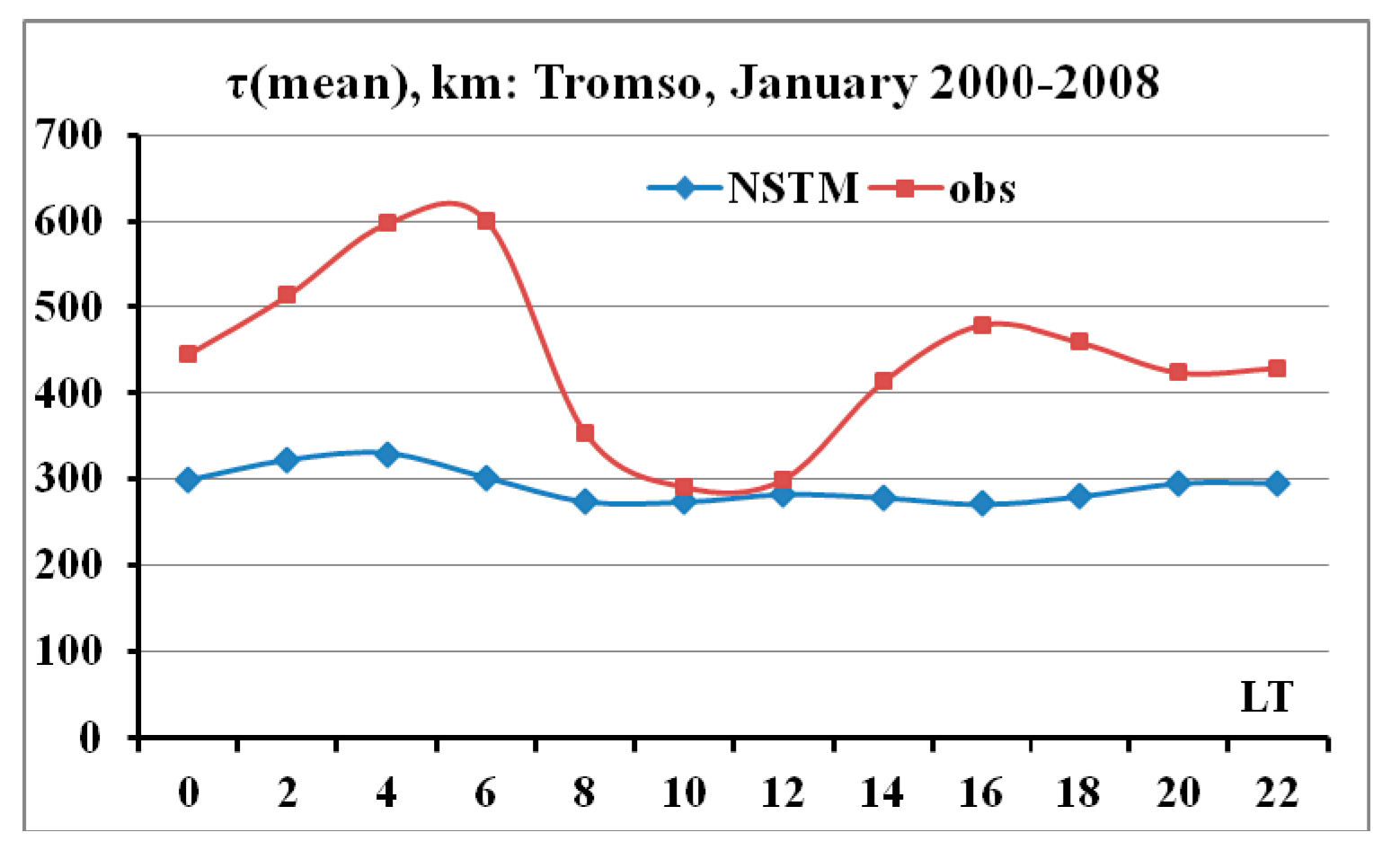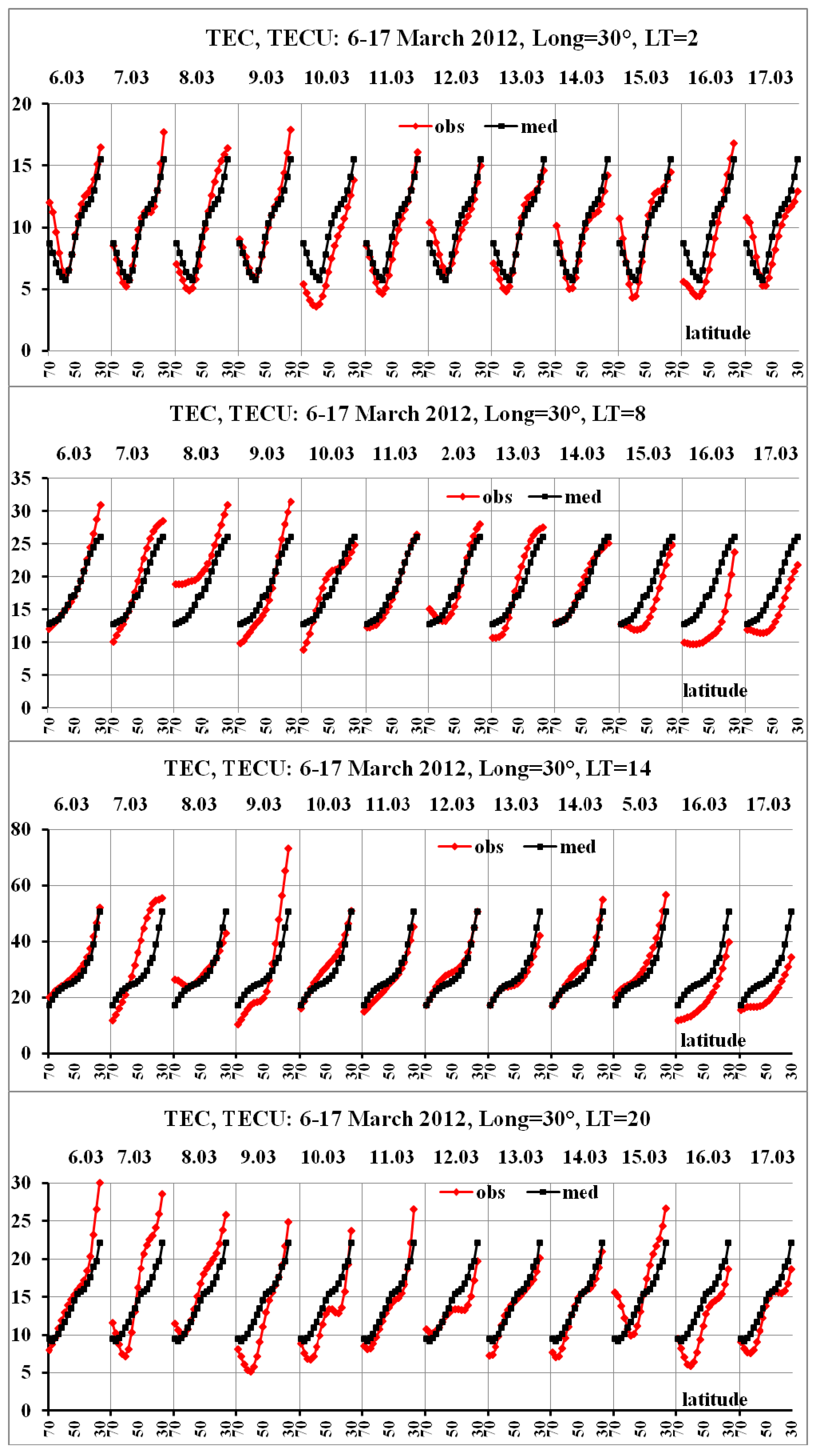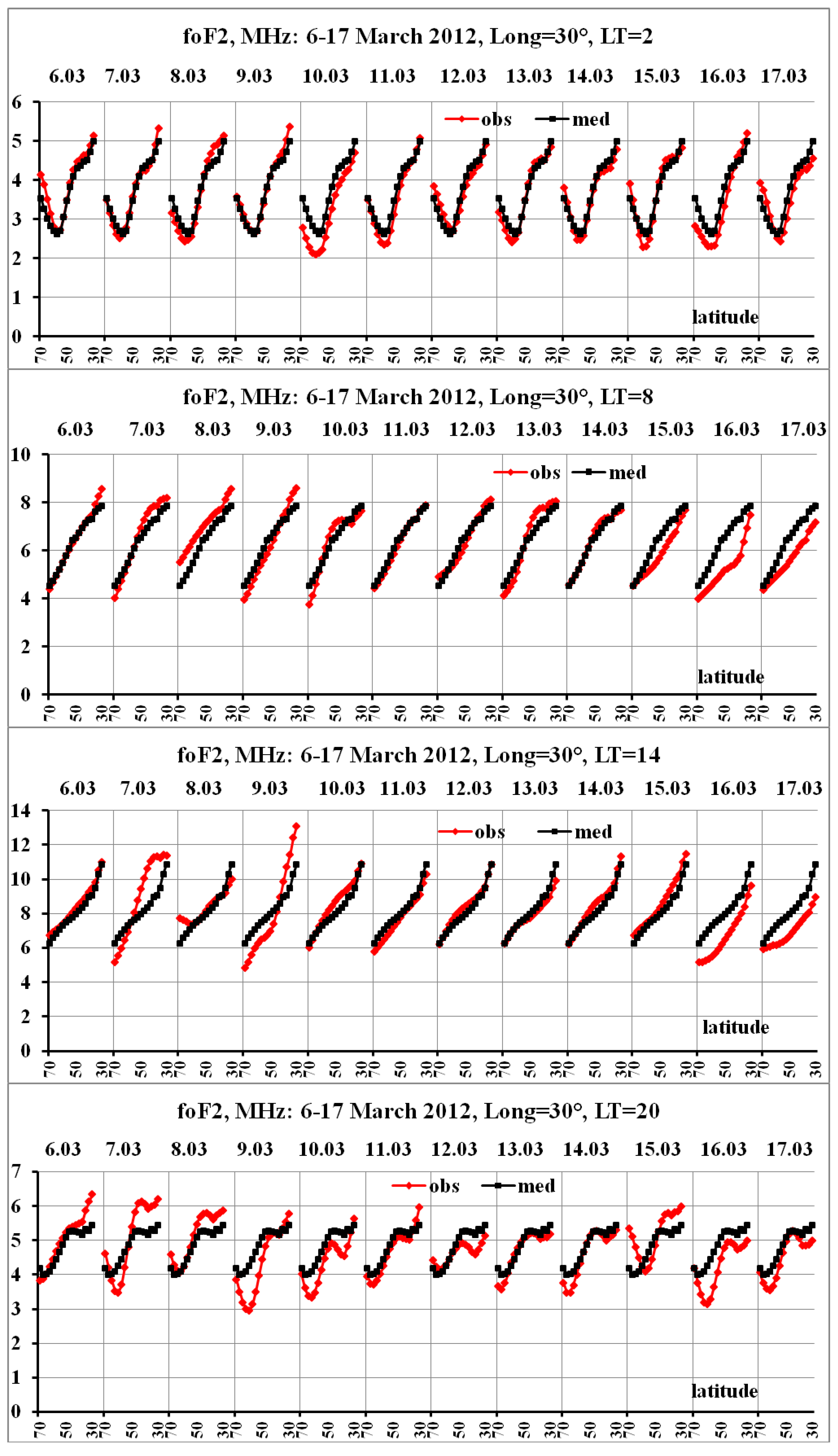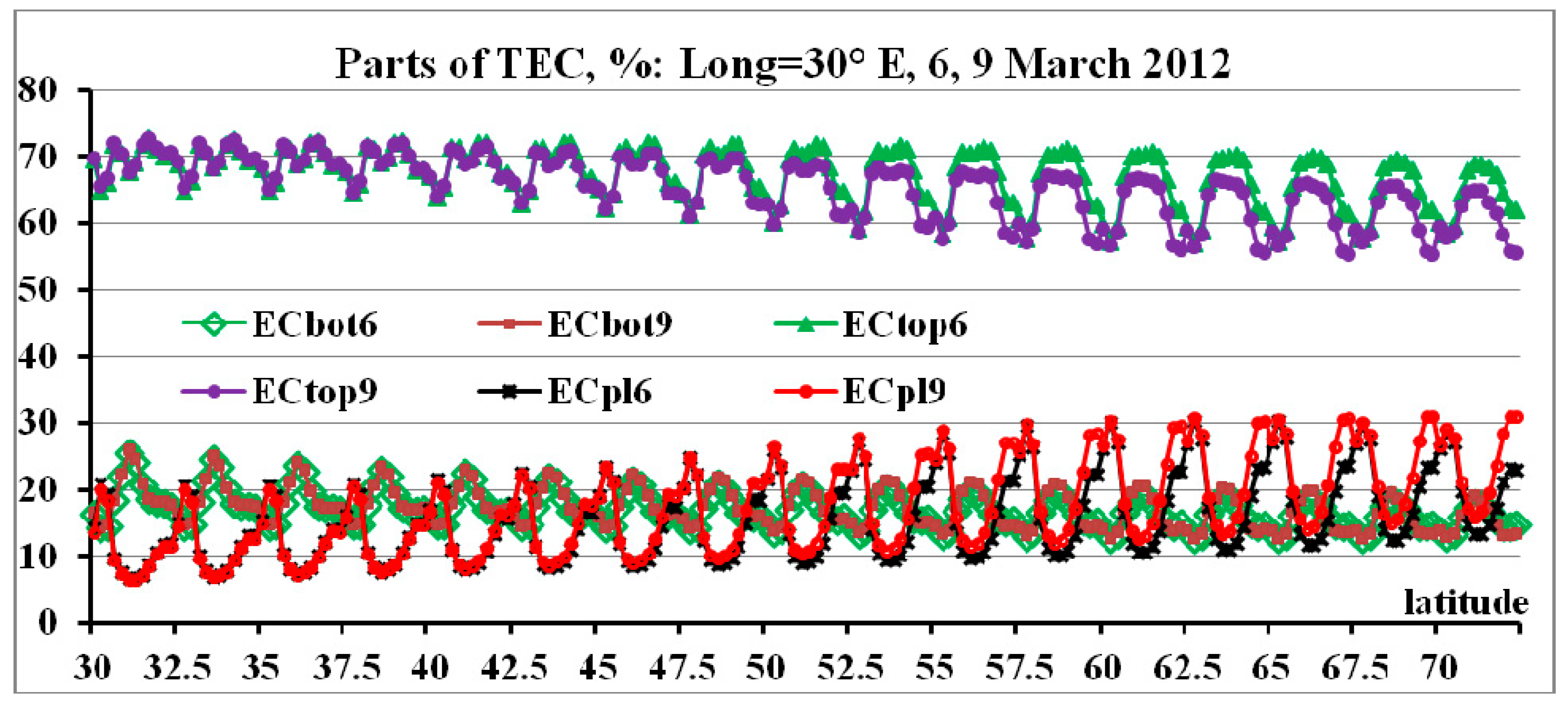Ionospheric Response along Meridian for the Certain Storm Using TEC and foF2
Abstract
1. Introduction
2. Experimental Data and Models
3. Results of Observations and Calculations
3.1. Behavior of Ionospheric Parameters According to Ionosonde Data
3.2. The Latitudinal Dependence of the TEC Response to Disturbances in the Period 7–17 March 2012
3.3. The Latitudinal Dependence of the foF2 Response to Disturbances in the Period 7–17 March 2012
4. Conclusions
Author Contributions
Funding
Data Availability Statement
Acknowledgments
Conflicts of Interest
References
- Davies, K. Ionospheric Radio Propagation. National Bureau of Standards Monograph 80; NIST Publications: Gaithersburg, MD, USA, 1 April 1965; 487p. [Google Scholar]
- Davies, K.; Liu, X.M. Ionospheric slab thickness in middle and low latitudes. Radio Sci. 1991, 26, 997–1005. [Google Scholar] [CrossRef]
- Hernández-Pajares, M.; Juan, J.M.; Sanz, J.; Orus, R.; Garcia-Rigo, A.; Feltens, J.; Komjathy, A.; Schaer, S.C.; Krankowski, A. The IGS VTEC maps: A reliable source of ionospheric information since 1998. J. Geod. 2009, 83, 263–275. [Google Scholar] [CrossRef]
- Bilitza, D.; Altadill, D.; Truhlik, V.; Shubin, V.; Galkin, I.; Reinisch, B.; Huang, X. International Reference Ionosphere 2016: From ionospheric climate to real-time weather predictions. Space Weather 2017, 15, 418–429. [Google Scholar] [CrossRef]
- Gulyaeva, T. International standard model of the Earth’s ionosphere and plasmasphere. Astron. Astrophys. Trans. 2003, 22, 639–643. [Google Scholar] [CrossRef]
- Hoque, M.M.; Jakowski, N. A new global empirical NmF2 model for operational use in radio systems. Radio Sci. 2011, 46, RS6015. [Google Scholar] [CrossRef]
- Jakowski, N.; Hoque, M.M.; Mayer, C. A new global TEC model for estimating transionospheric radio wave propagation errors. J. Geod. 2011, 85, 965–974. [Google Scholar] [CrossRef]
- Jakowski, N.; Hoque, M.; Mielich, J.; Hall, C. Equivalent slab thickness of the ionosphere over Europe as an indicator of long-term temperature changes in the thermosphere. J. Atmos. Sol. Terr. Phys. 2017, 163, 91–102. [Google Scholar] [CrossRef]
- Fron, A.; Galkin, I.; Krankowski, A.; Bilitza, D.; Hernández-Pajares, M.; Reinisch, B.; Li, Z.; Kotulak, K.; Zakharenkova, I.; Cherniak, I.; et al. Towards Cooperative Global Mapping of the Ionosphere: Fusion Feasibility for IGS and IRI with Global Climate VTEC Maps. Remote Sens. 2020, 12, 3531. [Google Scholar] [CrossRef]
- Jakowski, N.; Hoque, M.M. Global equivalent slab thickness model of the Earth’s ionosphere. J. Space Weather Space Clim. 2021, 11, 1–18. [Google Scholar] [CrossRef]
- Galkin, I.A.; Reinisch, B.W.; Bilitza, D. Realistic Ionosphere: Real-time ionosonde service for ISWI. SunGe 2018, 13, 173–178. [Google Scholar]
- Gulyaeva, T.L.; Arikan, F.; Hernandez-Pajares, M.; Stanislawska, I. GIM-TEC adaptive ionospheric weather assessment and forecast system. J. Atmos. Sol. Terr. Phys. 2013, 102, 329–340. [Google Scholar] [CrossRef]
- Tsurutani, B.; Echer, E.; Shibata, K.; Verkhoglyadova, O.; Mannucci, A.; Gonzalez, W.D.; Kozyra, J.U.; Pätzold, M. The interplanetary causes of geomagnetic activity during the 7–17 March 2012 interval: A CAWSES II overview. J. Space Weather Space Clim. 2014, 4, A02. [Google Scholar] [CrossRef]
- Belehaki, A.; Kutiev, I.; Marinov, P.; Tsagouri, I.; Koutroumbas, K.; Elias, P. Ionospheric electron density perturbations during the 7–10 March 2012 geomagnetic storm period. Adv. Space Res. 2017, 59, 1041–1056. [Google Scholar] [CrossRef]
- Verkhoglyadova, O.P.; Tsurutani, B.T.; Mannucci, A.J.; Mlynczak, M.G.; Hunt, L.A.; Paxton, L.J. Ionospheric TEC, thermospheric cooling and Σ[O/N2] compositional changes during the 6–17 March 2012 magnetic storm interval (CAWSES II). J. Atmos. Sol. Terr. Phys. 2014, 115–116, 41–51. [Google Scholar] [CrossRef]
- Gulyaeva, T.L. Modification of solar activity indices in the international reference ionosphere IRI and IRI-Plas models due to recent revision of sunspot number time series. Sol. Terr. Phys. 2016, 2, 87–98. [Google Scholar] [CrossRef]
- Huang, H.; Liu, L.; Chen, Y.; Le, H.; Wan, W. A global picture of ionospheric slab thickness derived from GIM TEC and COSMIC radio occultation observations. J. Geophys. Res. Space Phys. 2016, 121, 867–880. [Google Scholar] [CrossRef]
- Anh, V.V.; Yu, Z.; Wanliss, J.A.; Watson, S.M. Prediction of magnetic storm events using the Dst index. Nonlinear Process. Geophys. 2005, 12, 799–806. [Google Scholar] [CrossRef][Green Version]
- Balan, N.; Tulasiram, S.; Kamide, Y.; Batista, I.S.; Souza, J.R.; Shiokawa, K.; Rajesh, P.K.; Victor, N.J. Automatic selection of Dst storms and their seasonal variations in two versions of Dst in 50 years. Earth Planets Space 2017, 69, 59. [Google Scholar] [CrossRef]
- Fagundes, P.R.; Cardoso, F.A.; Fejer, B.G.; Venkatesh, K.; Ribeiro, B.A.G.; Pillat, V.G. Positive and negative GPS-TEC ionospheric storm effects during the extreme space weather event of March 2015 over the Brazilian sector. J. Geophys. Res Space Phys. 2016, 121, 5613–5625. [Google Scholar] [CrossRef]
- Prölss, G.W. Ionospheric F-region Storms: Unsolved Problems. In Characterising the Ionosphere (10-1–10-20). Meeting Proceedings RTO-MP-IST-056; RTO: Neuilly-sur-Seine, France, 2006; p. 10. Available online: http://www.rto.nato.int/abstracts.asp (accessed on 7 September 2021).
- Nishioka, M.; Saito, S.; Tao, C.; Shiota, D.; Tsugawa, T.; Ishii, M. Statistical analysis of ionospheric total electron content (TEC): Long-term estimation of extreme TEC in Japan. Earth Planets Space 2021, 73, 52. [Google Scholar] [CrossRef]
- Gerzen, T.; Jakowski, N.; Wilken, V.; Hoque, M.M. Reconstruction of F2 layer peak electron density based on operational vertical total electron content maps. Ann. Geophys. 2013, 31, 1241–1249. [Google Scholar] [CrossRef][Green Version]
- Krankowski, A.; Shagimuratov, I.I.; Baran, L.W. Mapping of foF2 over Europe based on GPS-derived TEC data. Adv. Space Res. 2007, 39, 651–660. [Google Scholar] [CrossRef]
- Pignalberi, A.; Habarulema, J.B.; Pezzopane, M.; Rizzi, R. On the development of a method for updating an empirical climatological ionospheric model by means of assimilated vTEC measurements from a GNSS receiver network. Space Weather 2019, 17, 1131–1164. [Google Scholar] [CrossRef]









| 0 | 2 | 4 | 6 | 8 | 10 | 12 | 14 | 16 | 18 | 20 | 22 | ||
|---|---|---|---|---|---|---|---|---|---|---|---|---|---|
| Ath | RSME | 81.4 | 64.0 | 105.3 | 85.8 | 62.7 | 53.0 | 49.4 | 59.7 | 90.3 | 111.6 | 140.0 | 67.8 |
| NRSME | 15.5 | 11.6 | 22.1 | 25.2 | 18.1 | 14.3 | 15.0 | 17.1 | 24.0 | 21.5 | 24.6 | 12.0 | |
| Mos | RSME | 273.5 | 257.1 | 93.5 | 90.1 | 98.2 | 68.7 | 47.2 | 53.3 | 144.5 | 171.6 | 186.8 | 292.8 |
| NRSME | 37.5 | 30.2 | 27.0 | 27.8 | 31.7 | 19.5 | 14.0 | 15.1 | 36.7 | 37.1 | 27.1 | 35.8 | |
| Mur | RSME | 136.1 | 91.7 | 106.0 | 50.4 | 50.5 | 63.0 | 56.5 | 44.8 | 175.5 | 152.2 | 125.9 | 115.2 |
| NRSME | 23.9 | 14.6 | 18.1 | 10.4 | 11.5 | 14.1 | 16.1 | 11.9 | 44.4 | 34.3 | 23.0 | 21.8 | |
| Lon | RSME | 223 | 156 | 137 | 207 | 205 | 249 | 159 | 129 | 225 | 198 | 133 | 215 |
| NRSME | 35 | 27 | 22 | 44 | 47 | 53 | 35 | 28 | 51 | 43 | 28 | 38 |
Publisher’s Note: MDPI stays neutral with regard to jurisdictional claims in published maps and institutional affiliations. |
© 2021 by the authors. Licensee MDPI, Basel, Switzerland. This article is an open access article distributed under the terms and conditions of the Creative Commons Attribution (CC BY) license (https://creativecommons.org/licenses/by/4.0/).
Share and Cite
Maltseva, O.; Kharakhashyan, A.; Nikitenko, T. Ionospheric Response along Meridian for the Certain Storm Using TEC and foF2. Universe 2021, 7, 342. https://doi.org/10.3390/universe7090342
Maltseva O, Kharakhashyan A, Nikitenko T. Ionospheric Response along Meridian for the Certain Storm Using TEC and foF2. Universe. 2021; 7(9):342. https://doi.org/10.3390/universe7090342
Chicago/Turabian StyleMaltseva, Olga, Artem Kharakhashyan, and Tatyana Nikitenko. 2021. "Ionospheric Response along Meridian for the Certain Storm Using TEC and foF2" Universe 7, no. 9: 342. https://doi.org/10.3390/universe7090342
APA StyleMaltseva, O., Kharakhashyan, A., & Nikitenko, T. (2021). Ionospheric Response along Meridian for the Certain Storm Using TEC and foF2. Universe, 7(9), 342. https://doi.org/10.3390/universe7090342





